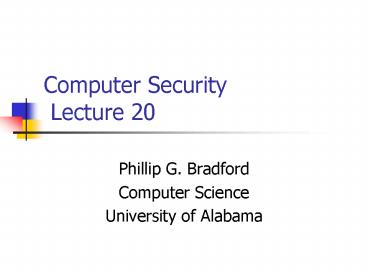Computer Security Lecture 20 - PowerPoint PPT Presentation
1 / 16
Title:
Computer Security Lecture 20
Description:
Lecture Outline. Review Last Lecture. Expansion. Xor. S-Boxes ... Each half of the key is 28 bits long! By the last bit rotate we are back at the beginning ! ... – PowerPoint PPT presentation
Number of Views:42
Avg rating:3.0/5.0
Title: Computer Security Lecture 20
1
Computer Security Lecture 20
- Phillip G. Bradford
- Computer Science
- University of Alabama
2
Lecture Outline
- Review Last Lecture
- Expansion
- Xor
- S-Boxes
- DES encryption and decryption
3
The Non-Linearity of S-Boxes
- Inputs 6 bits and outputs 4 bits
- 6 bits choose one of 64 outputs
- Each output is 4 bits
- Take the 3 bit in---3 bit out case
- 23 8 inputs
- 23 8 outputs
- Back to the 2n! Choices for an S-Box
4
The Non-Linearity of S-Boxes
5
The Non-Linearity of S-Boxes
- Even more so, the S-Boxes have the same elements
1 through 16 - Repeated 4 times!
- Thus, not invertible
6
The Invertibility of DES
- Li Ri-1 and Ri Li-1 xor f(Ri-1,Ki)
- L2 R1 and R2 L1 xor f(R1,K2)
- Inverses
- R1 L2
- L1 R2 xor f(R1,K2)
- L1 xor f(R1,K2) xor f(R1,K2) L1
- Then with R1 and L1 invert them!
7
The Invertibility of DES
- Li Ri-1 and Ri Li-1 xor f(Ri-1,Ki)
- Inverses
- R0 L1
- L0 R1 xor f(R0,K1)
- L0 xor f(R0,K1) xor f(R0,K1) L0
8
The Invertibility of DES
- The key schedule
- Note the sum of all of the bit rotates is 28
- Each half of the key is 28 bits long!
- By the last bit rotate we are back at the
beginning ! - What about those S-Boxes?
- 6 bits to 4 bits
- It does not matter!
- Xored in, but reversible
9
Double DES
- Double DES
- Two keys k1 and k2
- Encrypt c Ek2Ek1m
- So, m Dk1Dk2c
- Is this more secure than a single application of
DES? - If not, why not?
10
Meet in the Middle Attack
- Diffie Hellmans Analysis
- M-in-the-Middle is a general attack
- Given plaintext ciphertext pairs
11
Meet in the Middle Attack
- Given a known pair (m,c)
- Fact If c Ek2Ek1m,
- Then Ek1m Dk2c
- Encrypt m with all 256 possible keys k1
- For each k1 store (k1, c Ek1(m))
- Decrypt c using all 256 possible keys k2
- Store (Dk2(c),k2) for all k2
- Match the correct pair Dk2(c) Ek1(m)
12
Meet in the Middle Attack
- Analysis
- Given m, 264 potential cipher texts c
- Double DES has 2112 potential double keys
- For a plaintext m, the number of double keys that
can give c is at most - 2112/264 248
- Where c Ek2Ek1m
- So expect 248 false alarms for (k1,c Ek1(m))
13
Meet in the Middle Attack
- Suppose each Ek1 and Ek2 independently and
uniquely maps to - 264 domain elements
- Each of k1 and k2 fix E as a function with domain
and range of size 264 - Fix a plaintext m then Ek2Ek1m
- Maps to 264 ciphertexts
- Based on k1 and k2 of 2112 bits total
14
Meet in the Middle Attack
- Analysis, Cont.
- For (Dk2(c),k2), there are also 264 potential
ciphertexts that k2 can encrypt m into - This means 248/ 264 1/216
- Therefore, given (m,c), with probability 1- 1/216
we will determine the correct keys using
M-in-Middle
15
Double DES
- Key space of 256 is no larger using two
applications? - See Campbell and Wiener citation in book
- Say DES is not a group
16
Triple DES
- Three key versions
- Encrypt c Ek3Dk2Ek1m
- Decrypt m Dk1Ek2Dk3c
- Very large keys 54x3 168 bits
- Two keys
- Encrypt c Ek1Dk2Ek1m
- Decrypt m Dk1Ek2Dk1c































